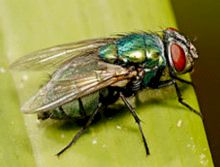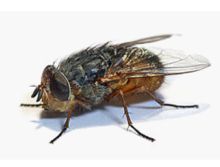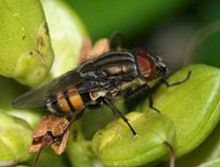| Common Name |
Hairy Maggot Blow Flies |
| Scientific Name |
Calliphoridae |
| Size |
10 - 12 mm in length |
| Colour |
Shiny with metallic colouring, often with blue, green or black
bodies |
| Description |
- The characteristics and arrangement of hairs are used to tell the
difference between members of this family. All blow-flies have bristles
located on the meron. Having two notopleural bristles and a hindmost
posthumeral bristle located lateral to pre-sutural bristle are
characteristics to look for when identifying this family.
- The thorax has the continuous dorsal suture across the middle, along
with well defined posterior calli. The post-scutellum is absent or
weakly developed. The costa is unbroken and the sub-costa is apparent on
the insect.
|
| Habitat |
- The typical habitat for blow-flies are temperate to
tropical areas that provide a layer of loose, damp soil and litter where
larvae may thrive and pupate.
- Maggots have hook-like mouthparts that tease apart tissues in which
they live. Adults have sponge-like mouthparts similar to those of house
flies. Larvae (maggots) primarily feed on dead animals and animal
refuge. Some feed on vegetation and others are obligatory parasites.
These flies are attracted to any type of fresh meat or road kill left in
the field.
|
| Lifecycle |
- Most species of blowflies studied thus far are anautogenous; a
female requires a substantial amount of protein to develop mature eggs
within her ovaries (about 800 µg per pair of ovaries in Phormia regina).
The current theory is that females visit carrion both for protein and
egg laying, but this remains to be proven. Blow-fly eggs,usually
yellowish or white in color, are approximately 1.5 mm x 0.4 mm, and,
when laid, look like rice balls. While the female blow-fly typically
lays 150-200 eggs per batch, she is usually iteroparous, laying around
2,000 eggs during the course of her life. The sex ratio of blowfly eggs
is usually 50:50, but one interesting exception is currently documented
in the literature. Females from two species of the genus Chrysomya (C.
rufifacies and C. albiceps) are either arrhenogenic (laying only male
offspring) or thelygenic (laying only female offspring).
- Hatching from an egg to the first larval stage takes about 8 hours to one day. Larvae have three stages of development (called instars); each stage is separated by a molting event. The instars are separable by examining the posterior spiracles, or openings to the breathing system. The larvae use proteolytic enzymes in their excreta (as well as mechanical grinding by mouth hooks) to break down proteins on the livestock or corpse they are feeding on. Blowflies are poikilothermic, which is to say that the rate at which they grow and develop is highly dependent on temperature and species. Under room temperature (about 30 degrees Celsius) the black blowfly Phormia regina can go from egg to pupa in 150-266 hours (6 to 11 days). When the third stage is complete the pupa will leave the corpse and burrow into the ground, emerging as an adult 7 to 14 days later.
- Life Cycle: Female flies lay eggs on or near suitable habitats. Tiny
maggots hatch from eggs in 6 to 48 hours. Maggots develop through three
stages (instars) on carrion for 3 to 9 days before leaving the food
source to pupate in soil. After 2 to 7 days in a prepupal stage, they
form a puparium from their last larval stage skin. A fourth larval stage
occurs within the puparium before pupation. Adult flies emerge 10 to 17
days after the formation of the puparium. Development from egg to adult
occurs in 16 to 35 days, depending on temperature and environmental
conditions.
|
| Disease Transmitted |
- Adults may be vectors for pathogens of diseases such as dysentery.
Flies, most commonly Calliphoridae, have frequently been associated with
disease transmission in humans and animals as well as myiasis. Studies
and research have linked Calliphora and Lucilia to vectors of causal
agents of bacterial infections. These larvae, commonly seen on decaying
bodies, feed on carrion while the adults can be necrophagous or
vegetative. During the process of decay, microorganisms and/or
mycobacterium may be released through the body and may become infected
during this process. Flies arrive at the scene and lay their eggs. The
larvae begin eating and breaking down the corpse simultaneously
ingesting these organisms which is the first step of one transmission
route.
- Paratuberculosis in cattle, pigs and birds (M. a. avium) have been
isolated and recovered from these flies through several different
experiments.
- Other potential vectors and threatening diseases include Rabbit
Hemorrhagic Disease Virus in New Zealand and Strike. Although Strike is
not limited to blow flies; these maggots are a major source of this skin
invasion causing lesions, and if severe enough, may be lethal. Strike
starts when blow-flies lay eggs in a wound or fecal material present on
the sheep. When the maggots hatch, they begin feeding on the sheep and
thus irritating it. As soon as the first wave of maggots hatch, they
attract more blow-flies causing the Strike. Currently, there is no
insecticides for blowfly prevention, but precautionary measures may be
taken, such as docking tails, shearing, and keeping the sheep overall
healthy.
- Salmonellosis has also been proven to be transmitted by the blow fly
through saliva, feces and tarsi. Adult flies may be able to spread
pathogens via their sponging mouthparts, vomit, intestinal tract, sticky
pads of their feet or even their body or leg hairs.
- As vectors of many diseases, the importance of identifying the
transmissible agents, the route and prevention are becoming increasingly
important. With the ability to lay hundreds of eggs in a lifetime and
the presence of thousands of larvae at a time in such close proximity,
the potential for transmission is high especially at ideal temperatures.
|
| Type of damage |
- The economic damage generally associated with the presence of this
fly species is the cutaneous myiasis commonly inflicted on livestock. In
Australia it is known to strike sheep but it is a secondary invader and
acts as a scavenger on necrotic tissue, and as a predator on other
maggots.
- This species may be considered beneficial since it has been used
successfully in the treatment of osteomyelitis and because it is
considered a "predatory maggot". It voraciously consumes the larvae of
other species, and even resorts to cannibalism when food resources are
depleted.
|
| Prevention |
Currently, there is no insecticides for blowfly prevention, but
precautionary measures may be taken, such as docking tails, shearing,
and keeping the sheep overall, healthy |







